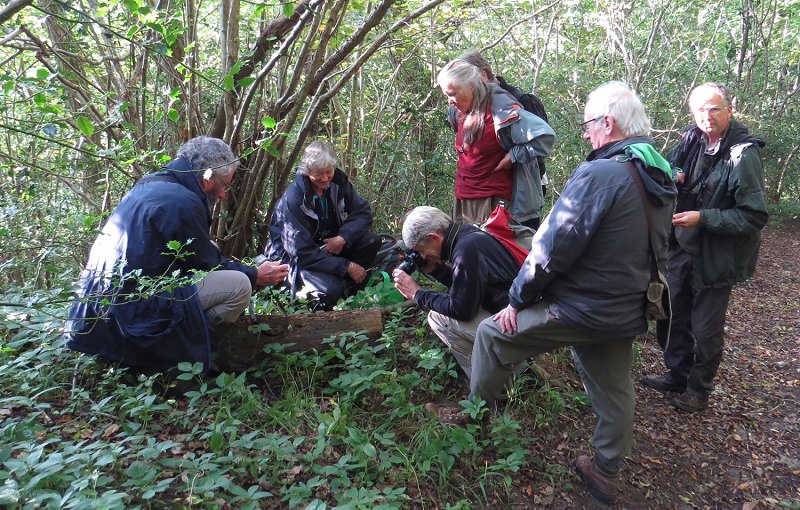
Back to the Home page
Species lists below
8 of us met at the corner of the road down into Sleightholmedale and walked down the slope through coppiced hazel and then through mixed birch, oak and larch. At the bottom of the slope we walked along the valley through beech wood and then back up the hill through hazel once again. On a recce a week before the foray I had see very few fungi except for one very exciting find at the top of the slope when I was almost back to the track, but more of that later...

On the day of the foray there were lots more fungi around, probably because of the weather and timing. Notable were the large numbers of tiny umbrella shaped whitish buff fungi, 2-6mm wide with a short white stipe 5 × 1mm, clustered on the fallen larch branches. This turned out to be Marasmius ramealis, known as the Twig Parachute. It is interesting because of the way the gills almost join in a ring near the stipe (“stalk”). We were then lucky enough to find the related species called Marasmius rotula as well, in which there are only a few wide spaced gills (19) that really do join in a complete collar around the stipe. The stipe in M. rotula is dark brown, stiff, and much longer at 40 × 1mm.
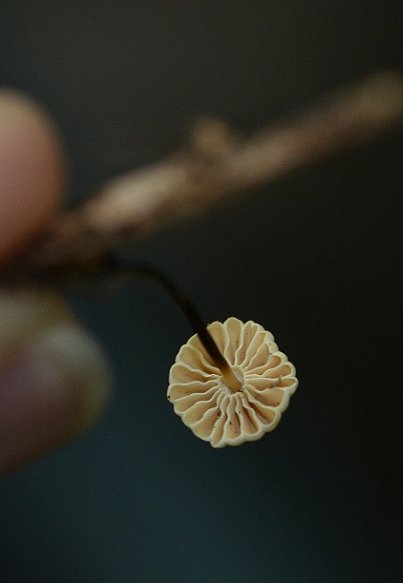 Marasmius rotula |
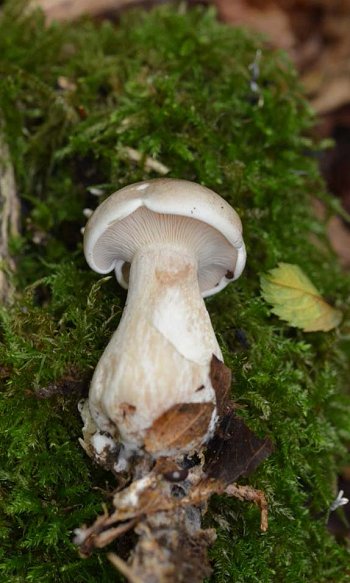
Clouded Agaric Clitocybe nebularis |
There were troupes of newly emerged Clitocybe nebularis – the Clouded Agaric, with their white and greyish-beige caps, cream decurrent gills and swollen stipes. Then there were the fresh specimens of Clitocybe geotropa which are robust and a pale cinnamon colour. As they age they have a distinct funnel shaped cap, but these newly emerged ones were paler and had small, almost flat caps, with wide and vaguely banded stipes.
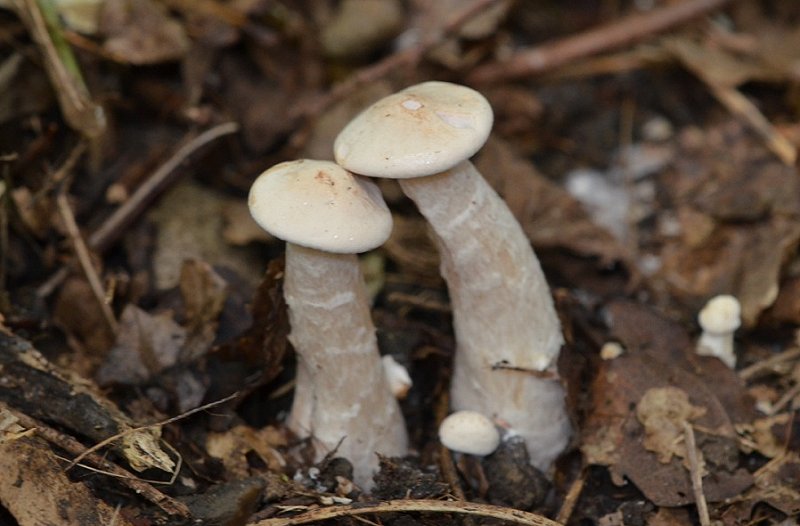
In the oak leaf litter there were numerous fungi with slightly pinkish beige caps that were almost golden in the centre and had milky coffee-coloured gills and white stipes covered in white flocci at the apex. These were Hebeloma sinapizans.
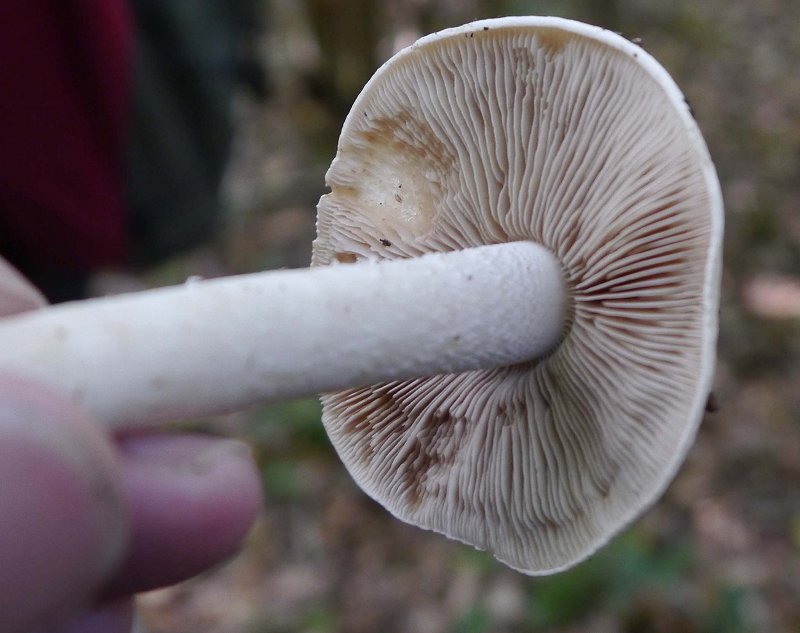
Hebeloma sinapizans
Under the beech lower down the slope were two species of Milkcaps. The Beech Milkcap Lactarius blennius with its slimy, dull, donkey-coloured caps which are often spotted and produce a hot-tasting white milk; and the Mild Milkcap Lactarius subdulcis – a brighter orange / brown colour with a smooth matt cap, often sunken in the centre and producing a cream coloured, mild-tasting milk that does not change colour when placed on a white cloth. As we walked down the path further, beside larch and birch we saw plenty of beautiful new specimens of the Common Puffball Lycoperdon perlatum with their soft conical spines. Even lower down the slope we saw a very different puffball – the Hedgehog Puffball or Spiny Puffball Lycoperdon echinatum. This is covered in long dense convergent spines. It is common in the south of England and known as far north as Perthshire but has only been recorded 14 times in VC62, the last record being in 1988!
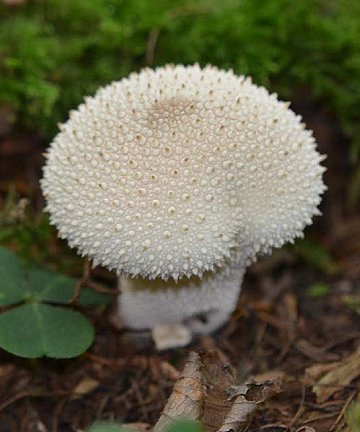 Common Puffball Lycoperdon perlatum |
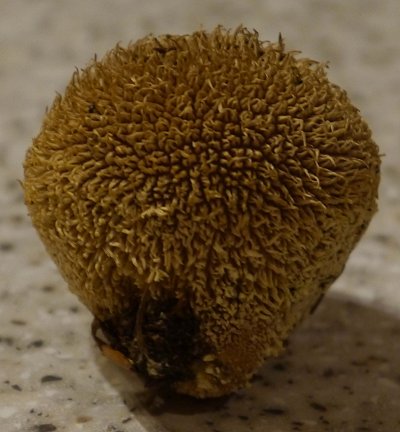
Hedgehog or Spiny Puffball Lycoperdon echinatum |
We were just ambling along the bottom path and had stopped to look at the strange pink Nail Galls on lime leaves, when Keith caught up with us holding out his hand to reveal a black patterned, potato-like structure. This caused us all to shriek “TRUFFLE?!” and indeed it turned out to be Tuber aestivum, the Summer Truffle. This was an absolutely fantastic find as they are subterranean and so really difficult to find. They are rare, having been recorded only 110 times in the UK and only TWICE in VC62, where the last record was in 1983 at Castle Howard.
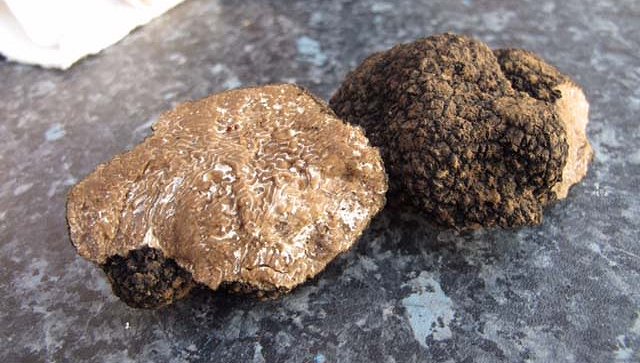
Summer Truffle Tuber aestivum
Then almost at the top of the slope I showed the members the exciting find I alluded to at the start of this report. On a recce a week before I had found these strange olive green Ascomycetes (cup fungi) on a very wet barkless log beside the track. They barely had a stalk and had a strange yellowish iridescence on the underside. I had never seen anything like them before and finally identified them as Chlorencoelia versiformis. I sent photos off to several people and a specimen to an expert friend in the Mid Yorkshire Fungus Group seeking confirmation and it was verified. This is very exciting as it has never been recorded in VC62 before, never mind Ryedale, and only 56 times in the UK. It is considered endangered and is on the 2006 RED DATA List. We thought the log was probably elm, and found a few more specimens on another nearby log probably from the same tree.
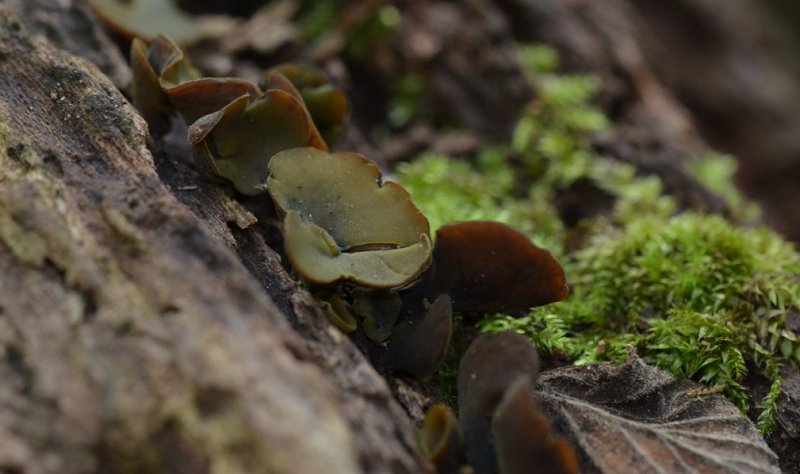
The rare ascomycete Chlorencoelia versiformis
We thanked Rhona for a fascinating afternoon; although we may not have seen huge numbers of fungi, but those that we did see were very interesting, including a handful of real rarities. Sometimes less is more... [Ed]
Spiders
Lepthyphantes tenuis, Lepthyphantes zimmermanni, Metelina mengei, Segestria senoculata (thanks to Jim for this list).
Birds
The only birds seen/heard were Carrion Crow, Robin and Blackbird – plus we found a dead young wren that seemed very thin and may have starved to death (thanks to Jim for this list).
Plants
As this was a fungus foray we did not record plants on this occasion.
Note this list contains a few species seen on the recce.
| Species Name | Association | Substrate | Id by |
|---|---|---|---|
| Biscogniauxia nummularia | Fagus | wood | RS |
| Bisporella citrina | Larix | wood | RS |
| Chlorencoelia versiformis | log | RS | |
| Clitocybe geotropa | Corylus | litter | RS |
| Clitocybe nebularis | Corylus | litter | RS |
| Conocybe juniana | Fagus | litter | ME |
| Cystolepiota bucknallii | Corylus | soil | RS |
| Daldinia concentrica | wood | RS | |
| Fomes formentarius | Betula | wood | RS |
| Gymnopus confluens | Corylus | litter | RS |
| Hebeloma sinapizans | Corylus | litter | RS |
| Hypholoma fasciculare | stump | RS | |
| Hypoxylon fuscum | Corylus | wood | RS |
| Inocybe microspora | Fagus | litter | ME |
| Lactarius blennius | Fagus | litter | RS |
| Lactarius subdulcis | Fagus | litter | RS |
| Lepiota cristata | Corylus | soil | RS |
| Lepista flaccida | soil | RS | |
| Lycoperdon echinatum | Fagus | litter | RS |
| Lycoperdon perlatum | Larix | soil | RS |
| Marasmiellus ramealis | Larix | twigs | RS |
| Marasmius rotula | Corylus | litter | RS |
| Marasmius wynnei | Corylus | litter | RS |
| Mycena arcangeliana | Corylus | wood | RS |
| Mycena pura | Corylus | soil | RS |
| Mycena vitilis | Corylus | litter | RS |
| Neobulgaria pura | Fagus | fallen branch | RS |
| Parasola auricoma | ME | ||
| Pholiota connisans | Fagus | fallen branch | RS |
| Piptoporus betulinus | Betula | stump | RS |
| Rhytisma acerinum | Acer | leaf | RS |
| Russula nigricans | litter | RS | |
| Russula ochroleuca | litter | RS | |
| Tricholoma terreum | Larix | soil | RS |
| Trochila ilicina | Ilex | leaf | RS |
| Tuber aestivum | Fagus | soil | KG |
| Xylaria hypoxylon | wood | RS |
37 spp. RS = Rhona Sutherland, ME = Melanie Earle.
| © Ryedale Natural History Society 2015, Photos © 2015 RNHS and Jayne Smith (Ryenats members), Keith Gittens (Truffle) and David Lewis |